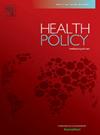澳大利亚全国心血管项目概述及对2021年至2024年试点的反思
IF 3.4
3区 医学
Q1 HEALTH CARE SCIENCES & SERVICES
引用次数: 0
摘要
心血管疾病(CVD)仍然是世界范围内死亡的主要原因。需要进行大规模的卫生系统改革,包括新的护理模式,以减轻心血管疾病的负担。在2021年至2024年期间,维多利亚安全护理与维多利亚州和澳大利亚联邦政府一起,在维多利亚州试行了一项创新的心血管计划。该计划旨在减少维多利亚州患有心血管疾病的人可避免的再入院,并改善居住在地区和农村地区的人获得心血管疾病护理的机会。该计划包括一系列举措,包括试点快速接入诊所和虚拟护理途径,以及促进住院病人管理和改善向社区过渡的新角色。在30个卫生服务机构中,10 670名被诊断患有心血管疾病或面临心血管疾病风险的人通过该规划获得了护理。与项目实施前相比,该项目总体上将30天内心血管疾病的全因再入院率降低了1%至14%(取决于病情类型和主动性),并改善了心血管疾病治疗的可及性,包括生活在地区和农村地区的人们。关键的成功因素包括种子资金、劳动力购买和计划的适应性。为了长期可持续性,该计划应考虑资源、技术要求、数据收集的优化以及与不同人群的相关性。从这一试点项目中吸取的经验教训可能对那些努力降低再入院率和改善农村患者获得心血管护理的机会面临挑战的司法管辖区有用。本文章由计算机程序翻译,如有差异,请以英文原文为准。
Overview of Australia’s state-wide cardiovascular program and reflections on its piloting between 2021 and 2024
Cardiovascular disease (CVD) remains a leading cause of death worldwide. Large-scale health system reforms, including new models of care are needed to reduce the burden of CVD. Between 2021 and 2024, Safer Care Victoria, together with the Victorian State and Australian Commonwealth governments, piloted an innovative Cardiovascular Program (Program) across the state of Victoria. The Program aimed to reduce avoidable readmissions for Victorians with CVD and improve access to CVD care for those living in regional and rural areas. The Program consisted of a range of initiatives including piloting rapid access clinics and virtual care pathways, as well as new roles to facilitate inpatient management and improve transition into the community. Across 30 health services, 10,670 people diagnosed with or at risk of CVDs received care through the Program. Compared to the pre-Program period, the Program generally reduced 30-day all-cause hospital readmissions for CVD by 1% to 14% (depending on condition type and initiative), and improved access to CVD care, including for people living in regional and rural areas. Critical success factors included seed funding, workforce buy-in and adaptability of initiatives. For long-term sustainability, the Program should consider resourcing, technical requirements, optimisation of data collection and relevance to diverse populations. Lessons learned from this pilot Program may prove useful for those jurisdictions where efforts to reduce readmission rates and improve access to cardiovascular care among rural patients have faced challenges.
求助全文
通过发布文献求助,成功后即可免费获取论文全文。
去求助
来源期刊

Health Policy
医学-卫生保健
CiteScore
6.40
自引率
6.10%
发文量
157
审稿时长
3-8 weeks
期刊介绍:
Health Policy is intended to be a vehicle for the exploration and discussion of health policy and health system issues and is aimed in particular at enhancing communication between health policy and system researchers, legislators, decision-makers and professionals concerned with developing, implementing, and analysing health policy, health systems and health care reforms, primarily in high-income countries outside the U.S.A.
 求助内容:
求助内容: 应助结果提醒方式:
应助结果提醒方式:


